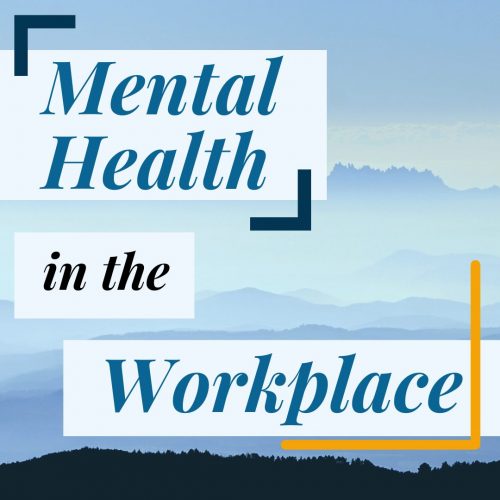Employee wellness is one of the highest trending topics in 2022, and for good reason: it is critical to business success. Industries the world over are looking to increase employee well-being in a bid to attract and retain top talent, boost morale and productivity, and ultimately, create a company culture that puts people and their physical and mental health at the forefront of their operations.
Wellness policies offer more than just long-term financial incentives for businesses.. The moral and ethical duty to care for our fellow people in the workplace, catalyzed by the pandemic, has us looking at mental and physical health from a new point of view — people want to work for companies that care.

How Organizations Can Address Mental Health
Mental illness and Substance-Use Disorders (SUDs) frequently overlap. An estimated one third of people with depression also have an alcohol problem, according to Addiction Center. The causes of depression and other mental health ailments may be down to genetics, trauma, or personal circumstances, but we must take steps to eliminate possible influences from the professional environment.
There are several ways to help employees who may be struggling with their mental health. Here are the steps that HR and management departments can take to protect their workplace and employees from mental health disorders, which in 2020 were experienced by 21% of U.S. adults (52.9 million people).
- Easy Access to Treatment
One of the most important ways to help colleagues suffering from some of the symptoms of poor mental health is to make the workplace a safe space. Google has a dedicated Mental Health Program offering onsite therapy for employees. When access to treatment is made as easy as possible, employees are more likely to engage.
The overarching benefit of onsite mental health facilities is that the employer is effectively communicating to their employees: “We understand that mental health can affect any one of us. Let us help you.”
- Destigmatization
As a society, we have started to advance in terms of the destigmatization of mental health disorders. Physical health issues are more evident and less vulnerable to subjective analysis. There is a less clear understanding of mental health issues because there are fewer external symptoms and less open dialogue about mental health in general. Complicating the situation further, mental health symptoms, internal or external, are oftentimes not easily recognized by colleagues and peers.
The nature of the symptoms that do materialize from poor mental health, however, comes in the form of behaviors that are traditionally stigmatized: dependency on alcohol and other substances, antisocial and self-sabotaging behavior, and alienation from friends, family, and peers. Turning a blind eye, or worse — cutting ties with the employee — is no longer an option.
- Well-being Packages
Gym membership, healthy snacks, and comprehensive healthcare coverage plans are undeniably beneficial to all employees, regardless of their mental state. But if we are investing in the creation and implementation of a holistic well-being package, we have to go beyond superficial perks to create a policy that offers treatment for the root cause of the issues, which could be in the company structure itself.
If you’re considering the creation of a well-being package for employees or already have a package in place, put the ball in their court. Ask them what they need. It offers valuable insight into the company’s systems and helps identify potential flaws in the current policy, plus it makes it more likely that any changes made are going to be adopted by employees.
- Monitoring
Regular check-ups including mental fitness tests and drug screening are a necessary step in company-wide well-being. Many businesses, due to the nature of their work, already include drug and alcohol screening in their day-to-day practices, particularly where on-site safety is a major concern. Even so, enterprises that don’t traditionally screen their employees can use screening to identify workplace SUDs and put treatment in place.
C-suite, management, and HR departments can lead by example insofar as screening is concerned. Reluctance to conduct regular drug screening programs or to be required to take drug tests can have a negative impact on the business and its employees. This is why internal communication about the reasons for drug screening and transparency regarding positive and negative test results, and what that means for the employees moving forward is so important. Clear communication on the schedule, the program rules, and benefits are vital to employee adoption.
- The Working Environment
Helping your employees to realize their full potential in terms of productivity and well-being can be carried out by evaluating the state of the company’s dynamics, both from a physical standpoint and a cultural one. Is the office physically conducive to employee well-being? Are office politics preventing employees from enjoying a stress-free working environment?
Workplace distribution and design can play an important role in employee mental health. Bright, artificial light; stale decor; loud, stressful physical environments with little respite can contribute to poor mental health. Biophilia is not a new concept, but as well-being policies garner more interest, green, sustainable design has been linked to improved mental health. Something as simple as adding plants to the office can have a positive effect on employee well-being, so why not start with that?
For industrial environments or workplaces that cannot permit a complete design overhaul, break-taking is key; and if the working schedule allows employees to get out into the open air, even better. You can further potentiate the impact of breaks by offering a means of social interaction.
Mindfulness and Empathy
There are many ways to monitor and improve employees’ mental health. It has gone beyond a simple ‘perk of the job’ to offer wellness facilities, and rather is the new norm, which isn’t any wonder — Gen Z is the generation that expresses the most concern with regard to mental well-being, a whopping 91% of Gen Z reported having felt at least one physical or emotional symptom of stress. As the sediment of the Covid-19 pandemic starts to settle, a new wave of mental health concerns edges closer and closer.
In the workplace, HR and management must remain vigilant and foot some of the responsibility for both prevention and cure of mental health issues and the frequently comorbid SUDs. Zero-tolerance policies are crucial in many working environments, and regular screening for malpractice is indisputable. But what happens to the employee when a SUD is flagged? There are many factors to consider, of course, but what if this is a valued employee, with a lot to offer, who is going through a particularly turbulent time in their life? Maybe, as business leaders, we can also contribute to the solution by scaffolding a support network in these cases — through the wellness packages in place and a bit of good old-fashioned empathy.

SUDs As A Symptom, Not The Problem
When Portugal decriminalized drugs in 2001, what ensued triggered a wave of questions and doubt over current anti-drugs laws. Portugal switched out repressive, outdated legislation and instead, began to view SUDs as a public health issue, treated as such: with dignity and medical care.
That’s not to say that the workplace or any other place, should be a free-for-all, where both recreational drug users and addicts can use freely without consequences. But if we begin to view SUDs as a symptom of poor mental health, both in the workplace and in the world, perhaps businesses and workplaces where we spend so much of our time can help remedy the problem at hand: an illness that affects our fellow humans.



